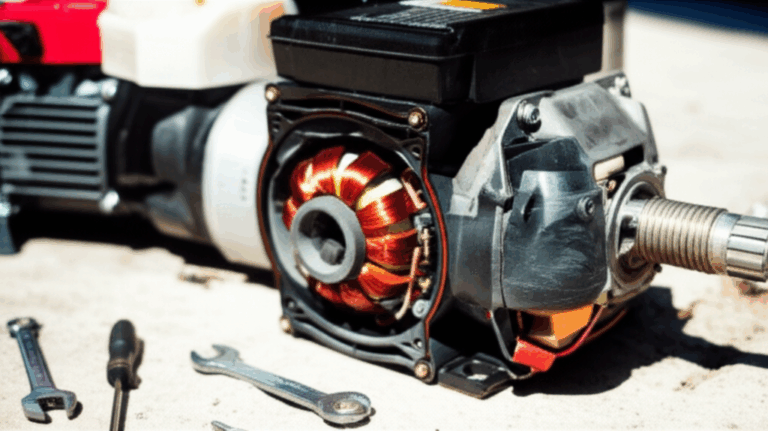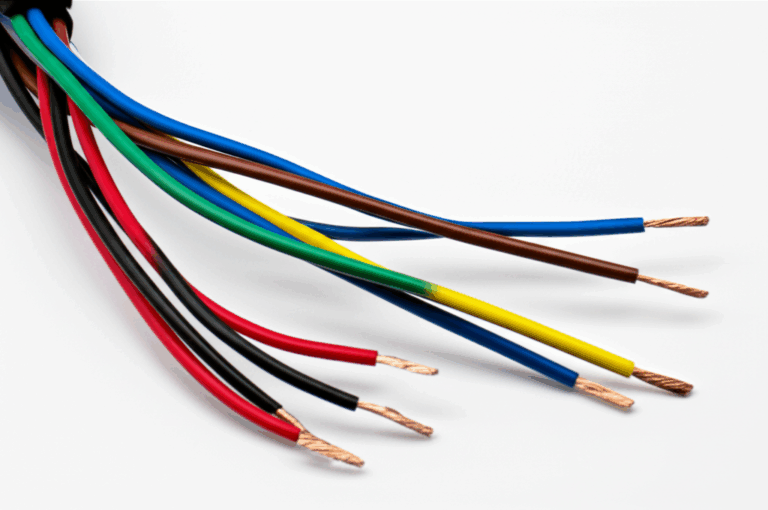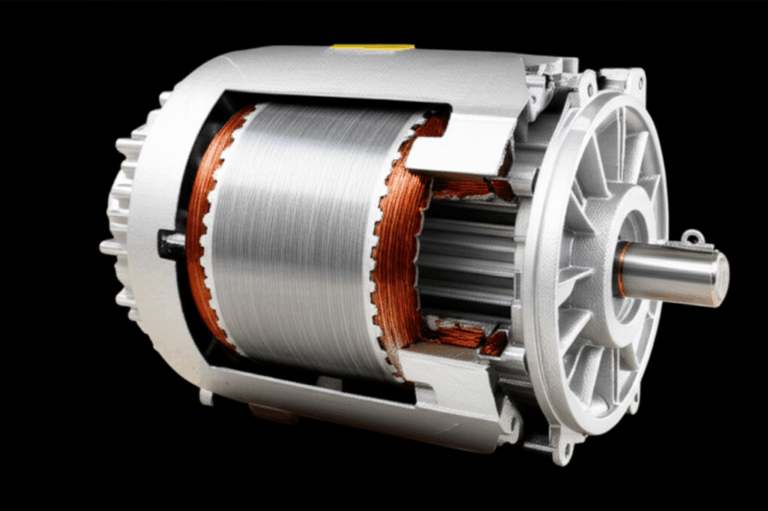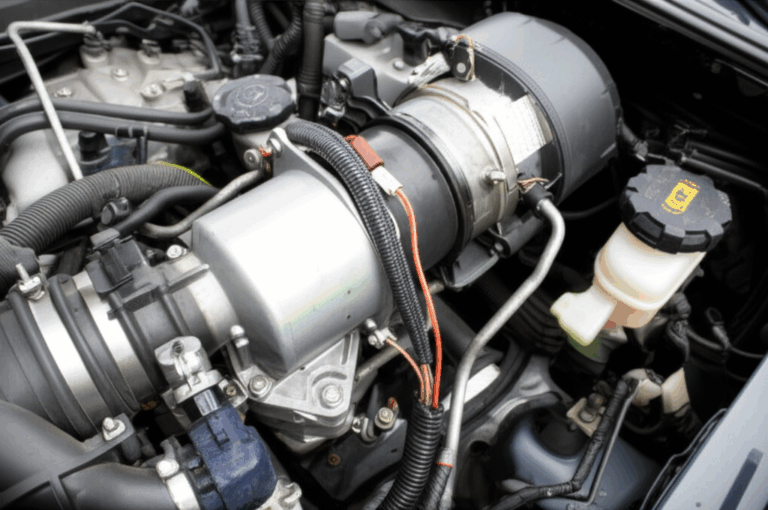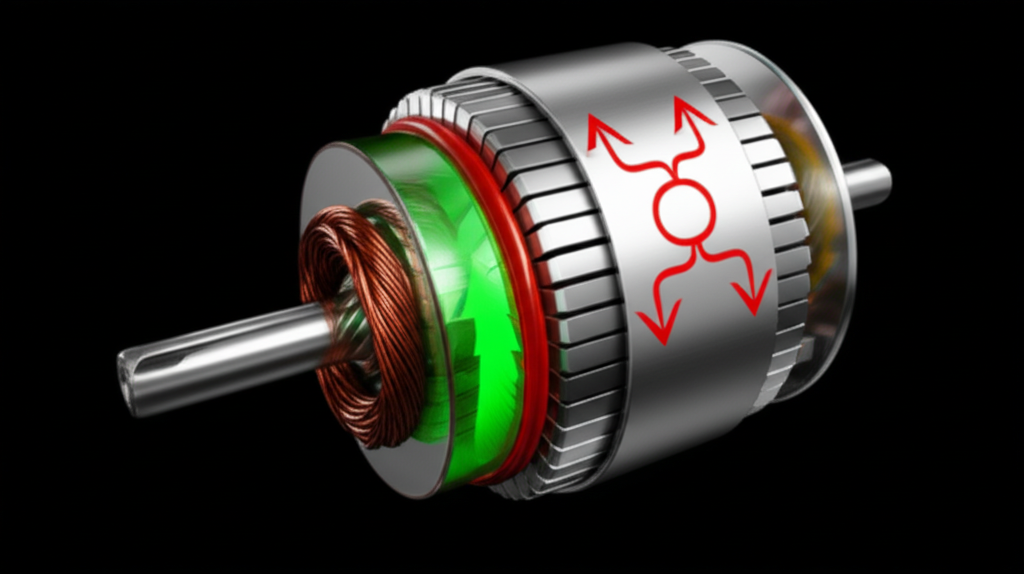
How Does an AC Motor Work? Understanding the Electrifying Principles of Motion
- Table of Contents
- How Does an AC Motor Work? Understanding the Electrifying Principles of Motion
- Why should you read this guide?
- What is an AC motor?
- How does alternating current create motion?
- What parts make up an AC motor?
- How does the magnetic field spin?
- How does the rotor start to turn?
- What are slip and synchronous speed?
- How do we control speed and save energy?
- What types of AC motors are there?
- How do materials and design boost efficiency?
- Where do we use AC motors every day?
- How do we start and protect AC motors?
- What do noise and vibration tell you?
- Who built the first AC motors?
- Fast facts and numbers you can trust
- FAQ
- Key takeaways
You flip a switch and a fan spins. Simple. Yet inside that motor a quiet dance turns electrical energy into mechanical energy. In this guide I break it down in plain words. You will see how alternating current makes magnetic fields, how the stator and rotor team up, and how torque makes the shaft turn.
Why read this? Because AC motors power your life. They run pumps, fans, fridges, compressors, and even some electric vehicles (EVs). When you get how they work you can spot problems fast, save energy, and choose the right motor for the job.
What is an AC motor?
An AC motor uses alternating current (AC) to make a spinning force called torque. That torque turns an output shaft. The motor does an electromechanical conversion. It turns electrical energy into mechanical energy. That is the heart of every drive, fan, and pump.
Problem: Motors seem like magic. You see wires, steel, and a case. No magic wand.
Agitate: If you do not know the basics you can pick the wrong motor or waste power. That hurts your bill and your gear.
Solution: Learn the simple rules. You will see how electromagnetism and alternating current principles create motion you can trust.
How does alternating current create motion?
When current runs in a wire it makes a magnetic field. This is electromagnetism. The field lines look like loops around the wire. Change the current and you change the field. This is Faraday’s law of induction at work. It tells us that changing magnetic flux makes voltage. Lenz’s law adds that the new current will fight the change. That push and pull sets the stage for motion.
AC flips direction many times each second. We call that the frequency. In many places it is 50 Hz or 60 Hz. AC keeps the field moving back and forth. That swing lets us create a rotating magnetic field. Once we have a field that spins we can make the rotor chase it. That chase makes the motor turn.
What parts make up an AC motor?
Inside you will find two main parts. The stator stays still. The rotor rotates. Between them sits a tiny air gap. That gap is small on purpose. A small gap improves torque and cuts loss.
- The stator has a steel core made from thin sheets called laminations. This design reduces eddy losses. The windings sit in slots. They carry AC and form poles. The quality of the stator core lamination sets the tone for low loss and strong magnetic field interaction.
- The rotor comes in two main flavors for induction motors. A squirrel cage rotor has bars and end rings cast in aluminum or copper. A wound rotor has coils that connect to the outside through slip rings and brushes. The rotor also uses laminated steel for the core. Good rotor core lamination reduces heat and boosts efficiency.
- A shaft runs through the rotor to carry power out. Bearings support the shaft. The frame and enclosure protect the parts and help cooling.
I like to think of the stator as the “track” and the rotor as the “runner”. The track makes a moving lane and the runner tries to keep up.
How does the magnetic field spin?
In a three-phase AC motor, each set of windings gets its own phase of AC. The three waves come in at different times. When they mix they form a smooth rotating magnetic field (RMF). The field spins at a set rate called the synchronous speed. That speed depends on the line frequency and the number of magnetic pole pairs.
What about a single-phase AC motor? One phase alone cannot make a natural RMF. So designers add tricks. A capacitor start motor uses a start cap to make a second phase. A shaded-pole motor uses a copper shading ring to shift the field. These tricks mimic a rotating field so the motor can start. After that the motor keeps going.
Picture the poles like a parade of magnets that spin inside the stator. The rotor magnets try to line up with those spinning poles. They never quite catch up. Yet they keep chasing. That chase gives us steady output shaft rotation.
How does the rotor start to turn?
The RMF cuts across the rotor bars. By Faraday’s law that changing flux induces a voltage in the bars. Current flows in the rotor. Lenz’s law says that induced current creates its own field that fights the change. The result is a field in the rotor that faces the stator field.
Now Lorentz force steps in. The cross of magnetic field and current makes a force on the bars. The forces add up into torque generation in AC motors. The torque turns the rotor. The dance repeats each cycle. The motor keeps turning as long as the AC feeds the stator.
This is the heart of an induction motor. No brushes touch the rotor in the squirrel cage type. That makes it strong and low care. In a wound rotor motor the slip rings and carbon brushes let you change rotor current. You can tweak starting torque vs running torque for special loads.
What are slip and synchronous speed?
The RMF spins at synchronous speed. The rotor spins a little slower. That tiny gap in speed is the slip. Slip makes the flux lines cut the rotor bars. No slip means no induction and no torque. So the rotor can never catch the field in an induction motor.
You can find synchronous speed with a simple idea. More poles means a slower field. Higher frequency means a faster field. That is the synchronous speed calculation in a nutshell. The rated speed of AC motors sits a bit below the sync speed due to slip. The right slip in induction motors gives strong motor performance curves for your load.
Problem: If you size the motor wrong the slip gets too high. You lose torque and make heat.
Agitate: Heat kills insulation and bearings. Downtime costs money.
Solution: Match load and rated power. Read the motor load characteristics and performance curves. You keep slip in the sweet spot.
How do we control speed and save energy?
Speed ties to frequency. That is why Variable Frequency Drives (VFD) work so well. A VFD changes the AC frequency and voltage. It lets the motor run slower or faster with smooth control. In pumps and fans this saves a lot of energy because power falls fast with speed.
Real results? Many plants report 20% to 50% energy cuts on pumps and fans with VFDs. You also improve power factor in AC motors with the right drive. You get soft starts that reduce locked rotor current and inrush. The motor runs cooler which helps thermal management in motors and boosts longevity.
If you want to see the physics in action watch an “induction principle animation”. You will see how the field and frequency control speed. Once you see it the VFD makes perfect sense.
What types of AC motors are there?
The big split comes here. Induction motors (asynchronous) and synchronous motors.
- Induction motors are simple, robust, and cost effective. They rule industry. The classic three-phase AC motor leads the pack. A single-phase AC motor runs small fans and household appliance motors.
- Synchronous motor rotors lock to the RMF. They run at exact synchronous speed. You see them in precise applications and power factor correction. Many use permanent magnets and become Permanent Magnet Synchronous Motors (PMSM). EV makers love PMSM for high efficiency and strong torque.
Other useful types:
- Brushless AC motor operation often means a PMSM with sinusoidal drive. Some call it BLAC. A BLDC motor uses trapezoidal drive yet you still find a bldc stator core much like PMSM.
- Reluctance motor principle uses rotor saliency. Synchronous reluctance motors meet high efficiency classes.
- Interior permanent magnet (IPM) motors hide magnets inside the rotor. Surface permanent magnet (SPM) motors mount magnets on the rotor face.
- Servo motors can be AC. They add feedback for tight control.
- Stepper motors may run on AC from a driver that pulses phases.
- Universal motor (AC/DC) runs on either source. It uses brushes and a commutator. It spins fast and fits small tools.
Here is a quick map.
| Motor Type | Rotor | Control | Notes |
|---|---|---|---|
| Induction (squirrel cage) | Bars and rings | VFD ready | Simple, robust, low maintenance |
| Induction (wound rotor) | Coils with slip rings | External resistors | High starting torque, adjustable |
| Synchronous (PMSM) | Permanent magnets | Inverter | High efficiency, EV grade |
| Synchronous reluctance | Salient rotor | Inverter | No magnets, high efficiency |
| Single-phase (capacitor start) | Squirrel cage | On/Off | Uses start capacitor |
| Shaded-pole | Squirrel cage | On/Off | Very simple, low torque |
| Universal (AC/DC) | Wound armature with brushes | Voltage control | High speed, more maintenance |
How do materials and design boost efficiency?
Great motors start with great steel. Stator core, rotor core, and lamination quality matter a lot. Thin, well cut laminations reduce loss. Tight stacks keep flux strong. Premium electrical steel laminations cut eddy currents. You can source them from trusted makers like electrical steel laminations, which helps raise motor efficiency and lower heat. For full assemblies you can look at complete motor core laminations that fit your design.
Designers also tune the air gap, winding turns, and magnetic field strength control. They pick pole-changing motors or use special wiring to change speed on the fly. They add the right motor insulation class. They choose cooling systems for AC motors like TEFC fans, open drip proof, or liquid cooling. They pick motor enclosure types that fit dust, water, and noise rules. They follow NEMA and IEC standards so the frame and mount match your plant.
Inside the rotor you may see rotor bars shaped to boost torque and cut noise. You may see end rings that lower loss. The core might use silicon steel laminations or specialty grades. Good balance keeps vibration in AC motors low. Clean air paths improve thermal management. All of this raises understanding motor efficiency from theory to action.
Problem: Poor materials waste watts as heat.
Agitate: Heat shortens life and raises your bill. It can even cook bearings.
Solution: Use quality laminations, tight stacks, and the right steel. Choose proven suppliers for stator core lamination and rotor core lamination. You get less loss and more torque per watt.
Where do we use AC motors every day?
You see industrial AC motors in conveyors, mixers, mills, and fans. Pumps in water plants run on three-phase AC motors. Compressors for HVAC use induction motors or PMSM. At home your fridge, washer, and fan motor use AC. In cars EVs use PMSM or induction for the main drive. Some use regenerative braking in AC motors to feed power back to the generator side of the inverter.
Power flows from the AC power supply for motors through cables to the drive and then to the motor. The shaft carries power transmission in motors to belts, gears, or couplings. The motor’s rated power of motors and rated speed tell you what it can do. Look at motor performance curves to match your load characteristics.
You even see the same physics in other gear. A transformer uses a static version of induction to move energy between coils. A generator is a motor run in reverse. Same field. Same flux. Different job.
How do we start and protect AC motors?
Start methods matter. Across-the-line starting gives full voltage at once. That makes high locked rotor current. It can trip breakers. Soft starters ramp voltage up to cut shock. VFDs start smooth and limit current. Wound rotor motors use external resistors to raise starting torque and then remove them.
Protection keeps the motor safe. Use overload protection for motors like thermal relays. Add PTCs in windings to sense heat. Use good cooling systems and keep vents clean. Follow NEMA MG-1 and IEC 60034 rules for ratings. Fix power factor with capacitors or a drive when needed. Watch back EMF in AC motors during coast down and braking. Drives handle this with braking choppers or by using regenerative braking.
What do noise and vibration tell you?
Noise and shake are clues. A loud hum can mean magnetic field issues or loose stacks. A rattle can mean worn bearings or misaligned shaft. High vibration in AC motors may point to bent rotors, soft bases, or bad couplings.
Troubleshoot with simple steps. Listen. Feel. Measure current. Check air gap for rub. Inspect motor insulation for burns. Clean out dust to help cooling. Many troubleshooting common AC motor issues start with the basics. Tighten bolts. Replace bearings. Balance the fan. You cut noise in AC motors and extend life.
Who built the first AC motors?
We stand on great names. Michael Faraday found the link between current and magnetic fields. He wrote the rules we now call Faraday’s law. Lenz’s law and Lorentz force came from careful tests that explained the push and pull.
Nikola Tesla took these ideas and made them work. In 1888 he showed the induction motor and the polyphase AC system. Westinghouse backed the work and built early systems. Later brands like General Electric (GE), Siemens, and ABB made AC motors that power the world today. That is why the history of AC motors links to the principles of electric motors we still use.
Fast facts and numbers you can trust
Here are simple facts you can use to guide choices.
| Topic | Fact |
|---|---|
| Energy use | Electric motors use about 45% to 50% of global electricity. In industry the share can reach 65% to 70%. |
| Market share | AC induction motors make up most industrial drives. Many reports place them near 70% to 80% of installed motors in plants. |
| Efficiency | Standard induction motors run about 75% to 90% efficient. IE3/IE4 premium efficiency motors often top 90% to 95%. PMSM can reach 95% to 97% in top designs. |
| VFD savings | Fans and pumps often save 20% to 50% energy with VFDs due to speed control. |
| Life | A squirrel cage motor can run 15 to 20 years or more with care. |
These numbers match what groups like the International Energy Agency and the U.S. Department of Energy report. They show why energy efficient motors and smart control matter so much.
FAQ
Q: What sets AC motors apart from DC motors?
A: AC motor vs DC motor comes down to the power source and control. AC motors use line AC and form a rotating magnetic field in the stator. DC motors use commutators and brushes or electronics to switch current in the rotor. AC units shine in simple, rugged jobs. DC and BLDC or PMSM shine where tight speed control or high torque density is key.
Q: Why can’t the rotor of an induction motor catch the field?
A: It needs slip to induce current in the rotor. No slip means no induced current and no torque.
Q: How do single-phase motors start?
A: They use tricks like a capacitor start motor or shaded-pole motor to make a fake second phase. That makes a starting push.
Q: Do standards matter?
A: Yes. NEMA and IEC set frames, ratings, and efficiency classes like IE1 to IE5. This helps with safe use and easy swap.
Q: Can I cut noise?
A: Use good mounts, align shafts, balance fans, and pick a motor with skewed rotor bars. Good motor frame construction and tight stator core stacks help too.
References
- International Energy Agency (IEA). Energy use in motors and systems.
- U.S. Department of Energy (DOE). Motor systems energy efficiency resources.
- NEMA MG-1. Motors and Generators. National Electrical Manufacturers Association.
- IEC 60034. Rotating electrical machines. International Electrotechnical Commission.
- Tesla, N. 1888. A New System of Alternate Current Motors and Transformers.
- Major manufacturers: ABB, Siemens, General Electric, Westinghouse. Efficiency datasheets and application notes.
Key takeaways
- AC motors turn electrical energy into mechanical energy with electromagnetic induction and a rotating magnetic field.
- The stator makes the spinning field. The rotor follows. The tiny air gap and solid motor core laminations set performance.
- Faraday’s law, Lenz’s law, and Lorentz force explain how we get torque.
- Slip is key in induction motors. Synchronous motors lock to the field.
- VFDs change frequency and voltage, so you get smooth speed control and big energy savings.
- Choose good materials like quality electrical steel laminations and tight motor core laminations. They lower loss and heat.
- Pick the right type for the job: squirrel cage, wound rotor, PMSM, reluctance, single-phase, shaded-pole, or universal.
- Watch noise and vibration. They warn you early about bearings, insulation, or balance issues.
- Use proper overload protection, good cooling, and clean power. You protect your motor and your budget.
- When in doubt ask for help. A good supplier can size the motor, choose the right windings and poles, and guide AC drive systems for top results.

